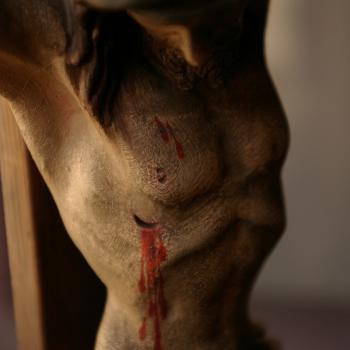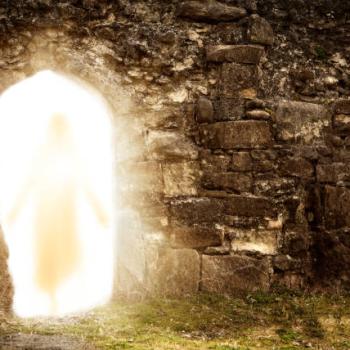
A group of scholars called the Context Group has added to the number of people having their say about Jesus and the Bible. Since the 1990’s their special contribution has been to take seriously studies of Jesus’ social, economic, and political environment. (At Patheos’ Messy Inspirations “Fellow Dying Inmate” often refers to context group scholars; e.g. here and here.) William R. Herzog II says the contest group’s work is one of many stages in the search for a usable Jesus of history, a search that began as long ago as the writing of the first Gospel.
“Usable Jesus” might not be what you think of as an appropriate goal for Bible historians. With that, aren’t the searchers putting their own needs in front of the actual past, the “real” Jesus? Herzog says those needs are necessarily there, often hidden, influencing the search and the findings. Best to acknowledge them at the start. Then they form a kind of hypothesis that one knows needs testing against the historical evidence. Herzog’s hypotheses include Jesus as “pedagogue of the poor” in his Parables as Subversive Speech” and Jesus as “prophet of the justice of the reign of God” in Jesus, Justice, and the Reign of God.
I wrote about the first book in a series of posts that concluded here. The second book, Jesus, Justice, and the Reign of God, will be the subject of the next series of posts. This is the second post in that series. The First post is:
The Historical Jesus and the Transcendent God in the Work of William Herzog.
Quests for the historical Jesus – a history
Herzog begins Jesus, Justice going over familiar territory with a brief history of the quest of the historical Jesus. That quest has gone through several stages, including one called “No Quest.” Here’s how Herzog dates the stages:
- First Quest, 1778-1901. A non-supernatural Jesus, shorn of doctrine and piety, looked like a nineteenth-century liberal.
- No Quest, 1906-53. Albert Schweitzer’s Quest of the Historical Jesus exposed the biases of the First Quest and made any such quest seem like an impossible dream. Jesus appears to be a mistaken messenger of apocalypse. Rudolf Bultmann and others concentrated instead on the preaching of the early Church. They investigated the life setting of that preaching in their quest for the historical Church.
- Second Quest, 1953 to about 1970. Students of Bultmann show how his methods can be extended beyond the preaching of the Church to Jesus himself. Jesus became an apolitical existentialist. Not the past or the future but only the moment of decision in the present mattered. The influence of existentialist philosophy contributed to divorcing Jesus from his Jewish environment.
- Third Quest, 1970 to present. The use of interdisciplinary studies enlarged the relevant data for the quest of the historical Jesus. An understanding of the social and political world of first-century Palestine made the existentialist interpretation of Jesus untenable. New questions arose like, “How does Jesus fit into the world of Roman colonial occupation, Herodian client rule, and the hegemony of the temple state?” (Jesus, Justice, p. 24) Eventually Jesus emerged as a figure involved in the politics and economics of his day. From these real-life dimensions the religion of the temple was never separate. Probably, Herzog says, it was Jesus’ politics that led to the cross. (p. 32)
The Context Group of Bible scholars, with which Herzog identifies, is part of this Third Quest.
Some Tools of the quest
Form criticism, redaction criticism, and literary criticism are some of the tools that help scholars delve into and behind the text of the Bible. These are names with which I have been familiar for some time. Herzog advanced my understanding of these tools considerably with his brief – but not too brief – presentations.
For instance, I knew that form criticism attempts to uncover the process that led to the writing of the Gospels. It finds oral traditions behind the text and their setting in the life of the Church. All well and good, but one also wants to know how it works. Herzog answers this wish by taking the time to give examples of Bible scholars use of each of the tools.
Oldest of the tools – Form Criticism
Form criticism identifies units of Scripture, called pericopes, and classifies them into literary genres. They might be poems, parables, sayings, prayers, etc. It also attempts to trace the history of a pericope and identify the life situation or situations that it served in that history. A pericope may have gone through several renditions in different life settings of the early Church. Herzog illustrates a parable’s possible path through multiple life settings with the Parable of the Ten Lepers. (Luke 17:11-19; p.73-76) Briefly:
First setting: Ten lepers approach Jesus and ask for mercy. Jesus tells them to show themselves to the priests. On the way they are healed. – By identifying this abbreviated form of the parable, scholars hypothesized an early healing ministry and a need for the Church to show that this healing models Jesus’ own.
Second setting: Only one returns to give thanks. Jesus asks where the other nine are. – With this addition the Church contrasts one’s act of worship to the inadequate faith of the other nine. Now the Church addresses a puzzle: Why, in spite of the Church’s practice of healing, did so few become part of the community? Faith is more than belief in healing power; it needs commitment.
Third layer: Luke adds an introduction, indicating Jesus was going through Samaria. Luke identifies the one who returned as a Samaritan and implies that the nine are Jews. Jesus praises the Samaritan: “Your faith has made you well.” – Like the Samaritan Gentiles couldn’t look to the Temple for integration into society. Luke makes the Samaritan a model for Gentiles in his community.
Evaluation
Of the three, form criticism reaches farthest back into the history behind the Bible. In this example we see three different settings in the life of the early Church. Early uses of form criticism, during the period of the “No Quest,” did not attempt to go farther back to the life of Jesus himself.
A setting in the life of Jesus
Herzog says Joachim Jeremias showed how form criticism could reach into the life setting of Jesus. He exemplifies with the Parable of the Sower and its interpretation in the biblical text. (p. 77-78)
The parable in a nutshell (Mark 4:3-8):
A farmer went out to sow. Some seed fell on the path, some on rocky ground, some among thorns, and some on good soil. Birds ate the seed on the path. The sun scorched the seedlings on rocky ground. Thorns grew up and choked seed sown among them. But the seed on good soil produced a bountiful harvest.
The interpretation (Mark 4:14-20):
The path represents those who hear the word, but Satan takes the word away. The rocky ground represents those who hear the word with joy but fall away when persecution arises. The thorns represent the cares of the world and the lure of wealth that choke the word. But the good soil represents those who “hear the word and accept it and bear fruit, thirty and sixty and a hundredfold.”
That’s how Mark’s text goes. Jeremias says the interpretation, which Mark puts in the words of Jesus, must instead be the work of the early Church. Both the language and the issue it raises, the psychological state of the hearers, are foreign to any setting in Jesus’ life. On the other hand, the parable itself contrasts the difficulty of Jesus’ mission with Jesus’ confidence in the eventual outcome. Jeremias thinks the parable points to Jesus’ eschatological hope in the face of opposition. Mark used the parable to address other needs of his community.
Politics and economics in the parable
Jeremias finds no hint of economics or politics in the opposition that Jesus encountered. His work is typical of the “Second Quest.”
In an earlier post I looked at Ched Myers’ interpretation of the Parable of the Sower. Myers, writing in the late 1990’s, may be following the lead of the Context Group. He finds not eschatological but political and economic hope in the parable’s abundant harvest.
Seven to one is a typical harvest. A bumper crop would be 10 to one. With a harvest of 100 to one a farmer could
… not only eat and pay his rent, tithes, and debts, but indeed even purchase the land, and thus end his servitude forever. (Myers, Binding the Strong Man, p. 177)
In this interpretation Mark’s Jesus addresses the hopes of all those working the land in a condition of oppression.
Regardless of which interpretation is closer to Jesus’ own, Jeremias has shown how form criticism can potentially reveal Jesus’ own life situation and thoughts.
Redaction criticism
Redaction is the work of the biblical author, adopting and modifying stories. Luke was redacting when he made the Lepers’ story serve a community that was having more success with Gentiles than with Jews.
Redaction criticism began, Herzog says, with German scholars in the 1950’s. It sees in the writers of Scripture not just collectors of traditions. They were genuine authors, tailoring stories to serve a vision of who Jesus could be for a community. Redaction critics focused on the differences among the Gospels, identifying, for example, different Christologies in each.
Herzog illustrates with the way Matthew changed a story that he found in the earlier Gospel of Mark.
The Stilling of the Storm. (Mark 4:35-41; Matthew 8:23-27)
The disciples are with Jesus in a boat, and Jesus is sleeping through a mighty storm. In Mark the disciples cry out to Jesus in fear, “Teacher, do you not care that we are perishing?” Before quieting the storm, Jesus answers, “Why are you afraid? Have you still no faith?” He implies they have no faith “still,” i.e., even after seeing many miracles.
Matthew, writing some years later, changed Mark’s story. Now the disciples’ cry is, “Lord save us! We are perishing.” They address Jesus with the majestic title “Lord.” In turn Jesus calls the disciples “you of little faith” – not no faith.
The context of Matthew’s story is an early Church setting, “not the world of the historical Jesus.” Jesus is “the Lord of the Church.” This community of faith needs reassurance that Jesus is with them. They get “a Christological reminder of the majesty of the Lord who has saved them.” (p. 83)
Evaluation
Redaction criticism represented a step away from the historical Jesus and even from the earliest Church. It aimed at the later situations of the various writers and, so, helped make clearer the meaning of a Gospel story.
Literary criticism
Literary approaches to the Gospels held the evangelists in higher esteem than the redaction critics had. Not just reformers of traditions, they were creative writers in their own right. Literary criticism, Herzog says, began in the late 1970’s and flourished in the 80’s. These critics viewed each biblical narrative as “a complete world in itself.” They analyzed story elements like “rhetoric, plot, characters, settings, narrator, and the narrator’s point of view.” (p. 84)
Herzog gives the example of Mary Ann Tolbert’s analysis of the Parable of the Sower. (p. 84-85) This parable, she says, summarizes the plot of the entire Gospel:
The path represents Jesus’ opponents throughout the Gospel—scribes, Pharisees, Herodians, Jerusalem Jews. The disciples, as Peter’s nickname, Rocky, suggests, are the rocky ground. They follow Jesus only to fall away at the crisis point. The thorny ground could be the rich ruler, who turns away, or Herod Antipas. Herzog says Tolbert is less sure about the good soil. He suggests “incidental characters who arise and show faith in Jesus.” One would be the Syrophoenician woman, whose persistent pleas for her daughter paid off. (Mark 7:24-30) Another, the formerly blind Bartimaeus, followed Jesus “on the way” after being healed. (Mark 10:46-52) I’d add the father of a boy who has a demon. He admits his imperfect faith: “I do believe, help my unbelief.” (Mark 9:24)
Thus, in the Parable of the Sower, Tolbert finds references to important elements throughout Mark’s story. This parable, she thinks, is a key to understanding the whole Gospel.
Evaluation
Contrasting two approaches, Herzog comments:
Jeremias is seeking the parable of the historical Jesus while Tolbert is seeking to understand the rhetorical function of the parable of the sower within the context of Mark’s narrative. (p. 86)
Literary criticism helps us understand the story an evangelist told. It’s disinterested in historical context except to the extent that every story has some context. Literary criticism does not look for the Jesus of history.
The Context Group and the use of social sciences
The “Third Quest” of the historical Jesus insisted on recognizing Jesus as a figure in the social, economic, and political setting of first-century Palestine. To that end, the Context Group made the use of the social sciences central to their search for the historical Jesus.
These researchers, first, found that it’s possible to draw general conclusions about today’s Mediterranean culture. Second, they inferred backwards in time to assess what first-century Palestinian culture must have been like. Herzog accepts what Bruce Malina, a leader in the Context Group movement, says about that culture. Malina finds five central values in the New Testament’s world: (p. 86)
- Honor vs. shame,
- The importance of the group for individual personality,
- The maintenance of inherited status in a limited-goods society,
- Kinship and marriage patterns,
- And the meaning of purity.
In a final illustration Herzog shows how this works with a Markan conflict text. (Mark 7:1-23)
Arguing over purity
Jesus and some Pharisees are arguing over the meaning of purity. The Pharisees focus on externals and complain because Jesus’ disciples eat with unwashed hands. Jesus’ attention is on the heart. Nothing that goes in past the lips defile because it goes not into the heart but out into the gutter. But what comes out from the heart can defile – murder, adultery, avarice, slander, pride, etc. Jesus has redefined purity to that which the Ten Commandments spell out. The Pharisees are all taken up with human traditions. (p. 87-88)
Here Jesus directly address the issue of purity, one of the key values in Jesus’ world. Elsewhere the issue is a subtle but still important factor. Pharisaical interpretations of purity stand in opposition to Jesus’ proclamation of the Kingdom of God.
For Context Group scholars the social sciences reveal “the material world and the political, social, and economic conditions of life, as well as the [people’s] values and convictions.” What used to be called background comes into the world of the New Testament itself. (p.88) New possibilities for discovering the historical Jesus open up. That is what Herzog will pursue in the rest of Jesus, Justice, and the Reign of God.












